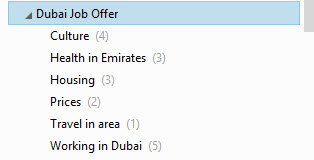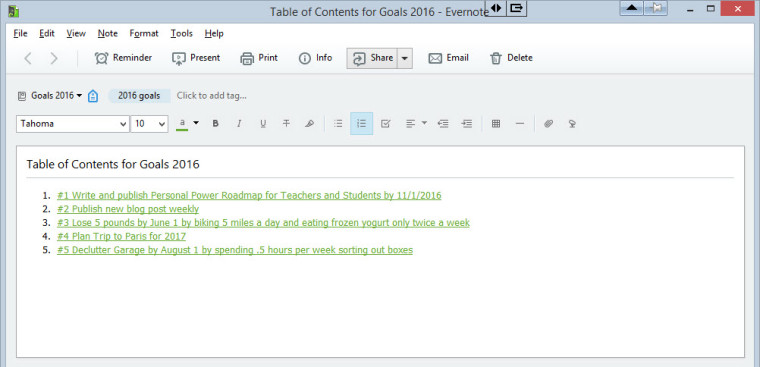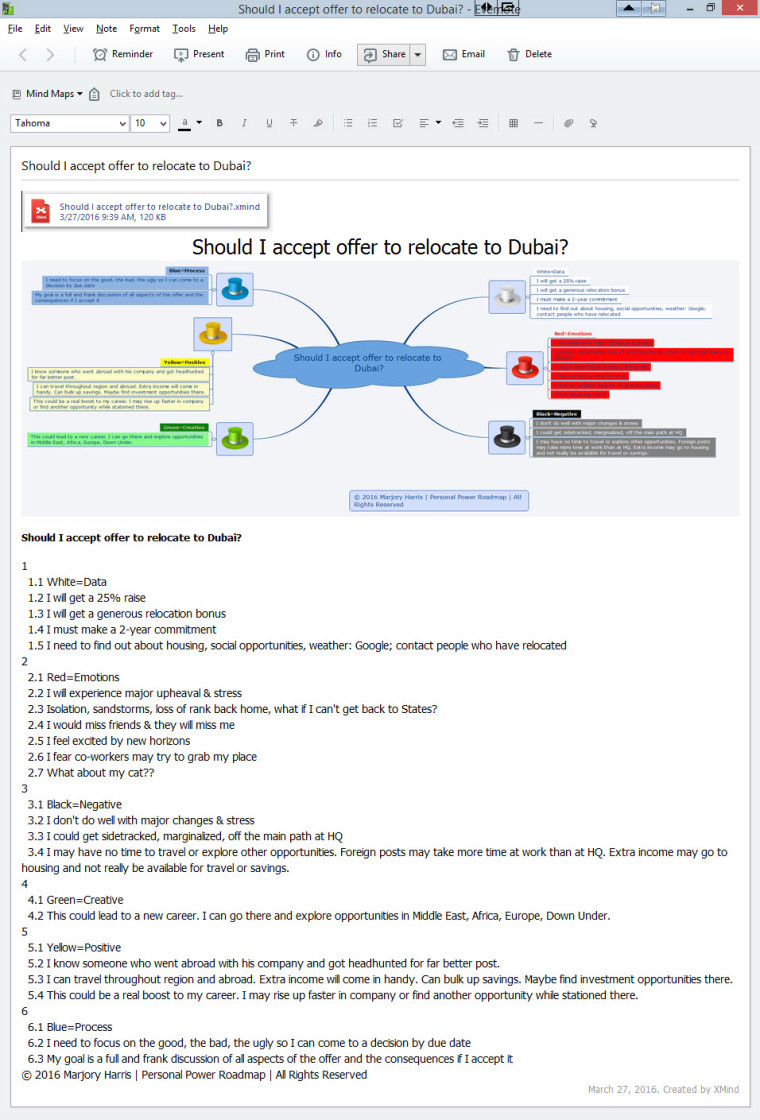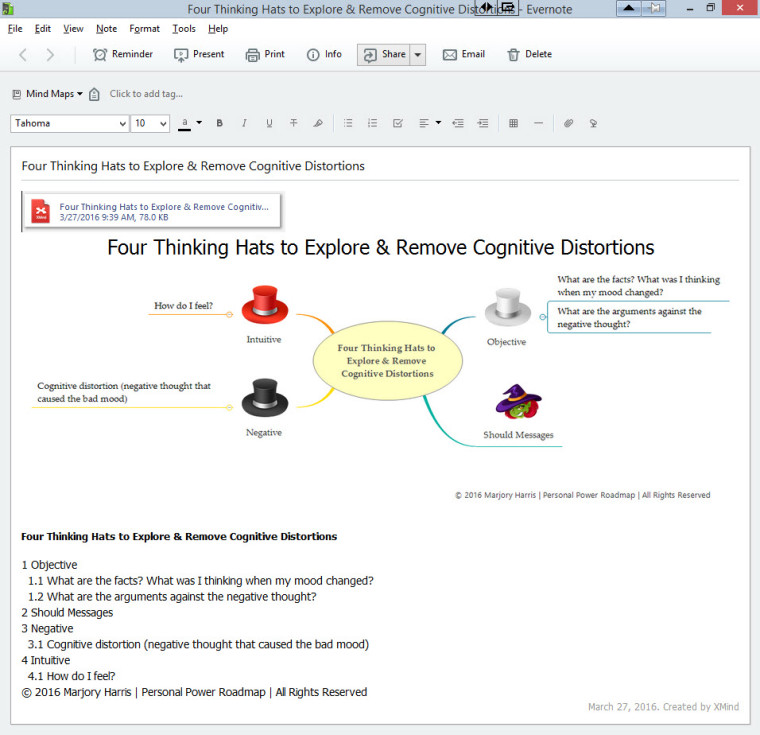Evernote is an ideal way to work with The Personal Power Roadmap 7-step system to effectively solve problems, make decisions, and reach your goals. Evernote is a free cloud-based program that works on all platforms and can be downloaded to your desktop. You can use it on your smartphone, tablet, or online. Just remember to sync when you make changes so your online database is updated. You’ll want to look at the “tips and tutorials” page for more ideas.
Because it connects to other programs such as Dropbox and Google Calendar, and also to most of the “to do” programs like Nozbe, DropTask, or Asana, Evernote makes record keeping a snap. For many it functions as a “digital brain.” It can also be your central clearing house and storage unit, where you collect bits and pieces of information, take photos (using a smartphone or notebook), record audio or text notes, set reminders, keep lists, etc.
Another benefit is the Evernote web clipper, a free extension for the popular browsers. Read this for more tips. Evernote makes it easier than ever to save research and ideas, whether they come from webpages or emails, notes you dictate or record, or photos you take of notes on post-its or napkins. If you have your smartphone with you, you always have access to Evernote.
How to install and use the Personal Power Roadmap with Evernote:
If you have not yet installed Evernote, go here. You can get the Personal Power Roadmap template into Evernote in two ways:
1st method:
- Download the Word template in portrait layout. Enable editing. Ctrl+A to highlight the entire document, then Ctrl+C to copy it.
- Create a new note in Evernote. Label it “Personal Power Roadmap Template.” Hit Ctrl+V to paste into the note. For Mac users, use “Command” instead of “Ctrl.” If you want to customize your template, the easiest way is to do it in Word, then paste it into Evernote .
2nd method:
Download Personal Power Roadmap for Evernote.enex. In Evernote, click on File menu, then Import, then select Evernote Export Files. Select the .enex file from the folder you downloaded to and click on Open.
These two methods work for using the Roadmap in sections (see below). Keep any templates in a folder on your hard drive or in the cloud. In Evernote, keep clean ones in a notebook so you can copy them when you need a new one.
Creating notebooks and tags:
Some people prefer organizing material in notebooks, others just rely on tags. Many use both.
I suggest you create a stack of notebooks for the problems you are working on. Go here for instructions. You can keep your charts in one of the notebooks in your problem stack. If you want this stack to show up at the top of your Notebooks list, just put “!” in front of it. You can add the stack to the shortcuts menu. Label one notebook in the stack “Templates.” Keep the Evernote template you downloaded from the link in this notebook, with any tweaks you made to it. Copy it as needed to other notebooks.
I suggest a notebook for each major problem, decision, project, or life change you are working on. Your Personal Power Roadmap goes in that notebook with research notes, emails you clipped, whatever relates to it. Make a shortcut out of your Personal Power Roadmap note. You can do this by right-clicking on the note and selecting “Add to Shortcuts.” Once in the Shortcuts menu, you can drag the item to the position you like. If you no longer need it on the Shortcuts menu, right click and select “Remove from Shortcuts.”
Example of how to convert a paper-based system into Evernote:
In Chapters 3 and 5 I talked about creating a business in a box when deciding to start my own law practice after more than seven years in a corporate setting. If I wanted to convert the “business-in-a-box” file box to Evernote, I would create a notebook stack, then put in notebooks with the same labels I used on the hanging folders in the actual box. Or I might just use one notebook and create a Table of Contents, a function built into the program that puts links on one note to all the notes in the notebook:
How to use the Roadmap chart in separate sections:
You may want to work on sections instead of the whole roadmap, especially when your Roadmap gets longer as you add research or research links. You can copy and paste from the entire roadmap chart into a new note, or use the sections notes you can download from here:
Tips and tricks for organizing and analyzing your research in Evernote:
In Chapter 5, there is a job-offer-in-Dubai exercise that illustrated using the Six Thinking Hats technique. The mind map raised issues that required research. Under Black Hat thinking, I was concerned that the extra income may go to housing and not be available for travel or savings. I Googled “cost of housing in Dubai” and found a cost-of-living chart I clipped using the Evernote web clipper. I found a few more articles and saved them for later reading. I saved the Google search page in Evernote for later reference. I then Googled “working abroad for your company” and found web pages devoted to the pros and cons of working abroad. I found a Forbes article that gave me a few more things to think about. In less than an hour online I found answers to many of my questions about life in Dubai and the effect on my career of working abroad. I created a table of contents note in Evernote that contained links to these notes:
Should I Accept Offer to Relocate to Dubai? Click image to enlarge. Download Mind Map
This is the mind map I created for the exercise using Six Thinking Hats in Chapter 5, “Figure It Out! Cognition Is the Second Essential Skill.”
Job Offer in Dubai Notebook Stack:
Screenshot of Notes in Dubai Notebook in Evernote:
Table of Contents Note in Evernote:
Reorganized Table of Contents Note in Evernote:
Use the Evernote template to set and reach goals:
Read the section above labeled “Creating notebooks and tags.” Each goal can have its own Roadmap, or even its own notebook. The notes can all be kept in a notebook labeled “Goals” with the year included. If you are using a notebook stack, then the label of the stack would be “Goals” and each notebook would have the name of the goal (e.g., “Find New Job”). Whether using notes or a stack of notebooks, you can prioritize your goals by adding a number (#1 or “1”) so they sort in order.
If you are working with a note for each goal in one notebook, add tags to all and make a Table of Contents note by highlighting the notes (Ctrl+A) and then selecting “Create Table of Contents Note.” The TOC note contains links to the notes that were highlighted. This note can be added to the Shortcuts menu for ease of use.
If you are working with a notebook stack and a notebook for each goal, just go to the Roadmap note (the master note), and on the top menu bar, select “Note.” A dropdown menu appears and you can select “Copy Note Link.” Then paste that into the note you create so you can link readily to all your goals. In other words, make a Table of Contents note by inserting the various goal master notes into one note, which you can then add to the Shortcuts menu.
Calendar a review of your goals every month, then pull up the TOC note and work through each Roadmap.
Use Evernote to store your Personal Power Roadmaps and mind maps:
Store your Personal Power Roadmaps for later use. Studying a past one when devising a new Roadmap helps avoid past problems. See it as a study guide, a learning tool. XX You can acquire knowledge readily using Internet search engines and store and categorize what you learned in Evernote. The free Evernote web clipper works best in Chrome.
I provided the Personal Power Roadmap as an Evernote template because more and more I find Evernote to be the easiest way to keep on top of everything. You can save your XMind templates to Evernote (see File menu) and the note contains a direct link back to the mind map and also lists any embedded notes at the bottom of the image. See this screenshot:
You can remind yourself, just by looking at the note in Evernote, what you need to do next. For the other mind maps in the Personal Power Roadmap book, I created these notes:
You can access all the mind map notes here.

















